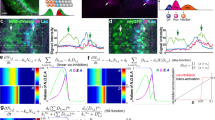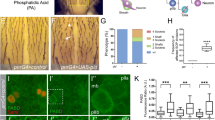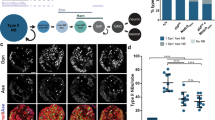Abstract
The Fringe protein of Drosophila and its vertebrate homologues function in boundary determination during pattern formation1,2,3,4,5,6,7,8,9. Fringe has been proposed to inhibit Serrate–Notch signalling but to potentiate Delta–Notch signalling10. Here we show that Fringe and Notch form a complex through both the Lin–Notch repeats and the epidermal growth factor repeats 22–36 (EGF22–36) of Notch when they are co-expressed. The Abruptex59b(Ax59b) and AxM1 mutations, which are caused by missense mutations in EGF repeats 24 and 25, respectively, abolish the Fringe–Notch interaction through EGF22-36, whereas the l(1)NB mutation in the third Lin–Notch repeat of Notch abolishes the interaction through Lin–Notch repeats. Ax mutations also greatly affect the Notch response to ectopic Fringe in vivo. Results from in vitro protein mixing experiments and subcellular colocalization experiments indicate that the Fringe–Notch complex may form before their secretion. These findings explain how Fringe acts cell-autonomously to modulate the ligand preference of Notch and why the Fringe–Notch relationship is conserved between phyla and in the development of very diverse structures.
This is a preview of subscription content, access via your institution
Access options
Subscribe to this journal
Receive 51 print issues and online access
$199.00 per year
only $3.90 per issue
Buy this article
- Purchase on Springer Link
- Instant access to full article PDF
Prices may be subject to local taxes which are calculated during checkout





Similar content being viewed by others

References
Irvine, K. & Wieschaus, E. fringe, a boundary-specific signalling molecule, mediates interactions between dorsal and ventral cells during Drosophila wing development. Cell 79, 595–606 (1994).
Kim, J., Irvine, K. D. & Carroll, S. B. Cell recognition, signal induction, and symmetrical gene activation at the dorsal-ventral boundary of the developing Drosophila wing. Cell 82, 795–802 (1995).
Papayannopuolos, V., Tomlinson, A., Panin, V. M., Rauskolb, C. & Irvine, K. D. Dorsal–ventral signaling in the Drosophila eye. Science 281, 2031–2034 (1998).
Cho, K. O. & Choi, K. W. Fringe is essential for mirror symmetry and morphogenesis in the Drosophila eye. Nature 396, 272–276 (1998).
Dominguez, M. & de Celis, J. F. A dorsal/ventral boundary established by Notch controls growth and polarity in the Drosophila eye. Nature 396, 276–278 (1998).
Esteban, C. R. et al. Radical fringe position the apical ectodermal ridge at the dorsoventral boundary of the vertebrate limb. Nature 386, 360–365 (1998).
Laufer, E. D. et al. Expression of Radical fringe in limb-bud ectoderm regulates apical ectodermal ridge formation. Nature 386, 366–373 (1997).
Zhang, N. & Gridley, T. Defects in somite formation in lunatic fringe-deficient mice. Nature 394, 374–377 (1998).
Evrard, Y. A., Lun, Y., Aulehla, A., Gan, L. & Johnson, R. L. Lunatic fringe is an essential mediator of somite segmentation and patterning. Nature 394, 377–381 (1998).
Panin, V. M., Papayannopoulos, V., Wilson, R. & Irvine, K. D. Fringe modulates Notch–ligand interactions. Nature 387, 908–912 (1997).
Kim, J. et al. Integration of positional signals and regulation of wing formation and identity by Drosophila vestigial gene. Nature 382, 133–138 (1996).
Kim, J., Magee, J. & Carroll, S. B. Intercompartmental signaling and the regulation of vestigial expression at the dorsoventral boundary of the developing Drosophila wing. Cold Spring Harb. Symp. quant. Biol. 62, 283–291 (1997).
Doherty, D. et al. Delta is an ventral to dorsal signal complementary to Serrate, another Notch ligand, in Drosophila wing formation. Genes Dev. 10, 421–434 (1996).
de Celis, J. F. & Bray, S. Feed-back mechanisms affecting Notch activation at the dorsoventral boundary in the Drosophila wing. Development 124, 3241–3251 (1997).
Klein, T. & Arias, A. M. Interactions among Delta, Serrate and Fringe modulate Notch activity during Drosophila wing development. Development 125, 2951–2962 (1998).
Kelley, M. R., Kidd, S., Deutsch, W. A. & Young, M. W. Mutations altering the structure of epidermal growth factor-like coding sequences at the Drosophila Notch locus. Cell 51, 539–548 (1987).
de Celis, J. F., Barrio, R., Arco, A. D. & Bellido, A. G. Genetic and molecular characterization of a Notch mutation in its Delta- and Serrate-binding domain in Drosophila. Proc. Natl Acad. Sci. USA 90, 4037–4041 (1993).
Brennan, K., Tateson, R., Lewis, K. & Arias, A. M. A functional analysis of Notch mutations in Drosophila. Genetics 147, 177–188 (1997).
Lyman, D. & Young, M. W. Further evidence for function of the Drosophila Notch protein as a transmembrane receptor. Proc. Natl Acad. Sci. USA 90, 10395–10399 (1993).
Blaumueller, C. M., Qi, H., Zagouras, P. & Artavanis-Tsakonas, S. Intracellular cleavage of Notch leads to a heterodimeric receptor on the plasma membrane. Cell 90, 281–291 (1997).
Logeat, F. et al. The Notch1 receptor is cleaved constitutively by a furin-like convertase. Proc. Natl Acad. Sci. USA 95, 8108–8112 (1998).
Johnston, S. H. et al. A family of mammalian Fringe genes implicated in boundary determination and the Notch pathway. Development 124, 2245–2254 (1997).
Yuan, Y. P., Schultz, J., Mlodzik, M. & Bork, P. Secreted Fringe-like signaling molecules may be glycosyltransferases. Cell 88, 9–11 (1997).
de Celis, J. F., Garcia-Bellido, A. & Bray, S. J. Activation and function of Notch at the dorsal–ventral boundary of the wing imaginal disc. Development 122, 359–369 (1996).
Lieber, T. et al. Antineurogenic phenotypes induced by truncated Notch proteins indicate a role in signal transduction and may point to a novel function for Notch in nuclei. Genes Dev. 7, 1949–1965 (1993).
Kopan, R., Schroeter, E. H., Weintraub, H. & Nye, J. S. Signal transduction by activated mNotch: Importance of proteolytic processing and its regulation by the extracellular domain. Proc. Natl Acad. Sci. USA 93, 1683–1688 (1996).
Han, K. An efficient DDAB-mediated transfection of Drosophila S2 cells. Nucleic Acids Res. 24, 4362–4363 (1996).
Johansen, H. et al. Regulated expression at high copy number allows production of a growth-inhibitory oncogene product in Drosophila Schneider cells. Genes Dev. 3, 882–889 (1989).
Brand, A. H. & Perrimon, N. Targeted gene expression as a means of altering cell fates and generating dominant phenotypes. Development 118, 401–415 (1993).
Acknowledgements
We would like to thank G. Panganiban for helpful comments; D. Kim, A. Hudson and J. Wilson for help in manuscript preparation; P. Fernandez and A. Garcia-Bellido for Ax mutant fly stocks; T. Klein, H. Marc, and A. Martinez-Arias for UAS-Dl and Dl-lacZ fly stocks; K. Basler for the FLPase38 stock; E. Knust for Ser antibody; R. Fleming for the hsp70-Gal4 stock and the construct to express Ser in S2 cells; Muskavitch for the construct to express Dl in S2 cells. S.B. is an investigator of the Howard Hughes Medical Institute. This work was supported by KAIST BK21 program to J. Kim and a grant to J. Yim from Creative Research Initiatives of the Korean Ministry of Science and Technology.
Author information
Authors and Affiliations
Corresponding author
Rights and permissions
About this article
Cite this article
Ju, BG., Jeong, S., Bae, E. et al. Fringe forms a complex with Notch. Nature 405, 191–195 (2000). https://doi.org/10.1038/35012090
Received:
Accepted:
Issue Date:
DOI: https://doi.org/10.1038/35012090
This article is cited by
-
Origin and evolution of the Notch signalling pathway: an overview from eukaryotic genomes
BMC Evolutionary Biology (2009)
-
Glycosylation regulates Notch signalling
Nature Reviews Molecular Cell Biology (2003)
Comments
By submitting a comment you agree to abide by our Terms and Community Guidelines. If you find something abusive or that does not comply with our terms or guidelines please flag it as inappropriate.


